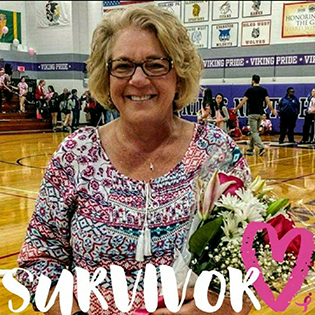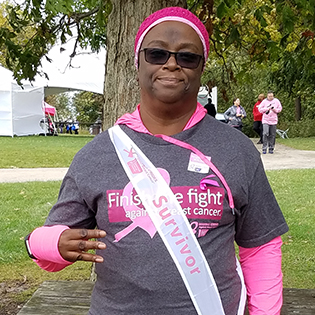Two Women Talk About Breast Cancer and The Power To Fight It
Oct 27, 2017 | 5 MIN READOn October 20th, Rita Grawe, wife of one of ELCO’s Vice Presidents, along with Janice Bradford a Policy Owner Service team member, unveiled the last two years of their lives as cancer survivors. What unfolded in their stories was the similarities and powerful differences. Each woman was diagnosed at the age of 56. Each had no family history of breast cancer. Each woman was diagnosed through a yearly mammogram. Cancer was not just existent in the month of October, but was a daily, monthly, and “throughout the year” kind of disease. That was pretty much the extent to their similarities. The power to fight this disease came about because of their different approaches to their diagnosis. Because there are subtle differences between the types of breast cancer, every individual patient will have her own unique struggles to face. Each stage of cancer comes with different forms of treatment. As I learned, both Rita and Janice are still working through them, almost two years later. Rita’s and Janice’s approach to their diagnosis was directly related to how they approach everyday life.
Both Rita and Janice remember the metal marker being put under the skin to mark where their tumor was for the biopsy. Rita remembers the overwhelming feeling as the incision was made, and said, “there wasn’t even any time to think”. Janice still has that marker in her. How and what was their family doing with all this going on, I asked? Rita lives in a home with all men. She has an incredibly supportive husband. And, although her three sons were very supportive too, they didn’t know how to talk about it. She turned to her church, where she met with a support group. Janice has two sons and a daughter. Her boys reacted similarly. She said her oldest son Tony, went to hug her and, “thought he was going to break me”. “They were scared but supportive”. Janice’s mother Florence was the one in her family she talked to and received her support from. She passed away this summer. Work was another issue for them. Rita’s fatigue was a big factor. Another side-affect from the radiation was the giant sunburn and itching. She asked the Nurse Navigator, “why am I being diagnosed now with breast cancer? I have no family history”. The response, “you are a woman, you have breasts, and you are post-menopausal”. She never asked that question again. After Janice had her first chemo treatment, she cried it out, got up, and said, “no more”. Janice had been warned of the side-affects, but until she experienced them… Her treatment took its toll at work. She was out on Wednesdays, Thursdays, and Fridays, to make it through the weekend pain. After losing her hair, she realized it was just hair. Now, she feels like she just took one for the team. Aside from Janice’s own story, she has had two nieces diagnosed with breast cancer, all in less than 5 years.
So, what happens next, we ask? Treatment is finished, but the effects are lasting, and the support is still needed. The next 5 years of follow-ups is a constant reminder.  Rita’s approach was to start attending Yoga classes through the cancer center 2 weeks after radiation started. She has met all kinds of cancer survivors, and “loves these women”. The picture for this article was taken at a local volleyball game, where she was honored, and was able to speak to those young women. I believe it speaks volumes about Rita.
Rita’s approach was to start attending Yoga classes through the cancer center 2 weeks after radiation started. She has met all kinds of cancer survivors, and “loves these women”. The picture for this article was taken at a local volleyball game, where she was honored, and was able to speak to those young women. I believe it speaks volumes about Rita.  Janice took a different path for continual recovery. She attends meetings with those who talk and support. These meetings are for caregivers too. One night in particular impacted her, when a husband and caregiver for his wife opened a notebook. In it, tons of questions. He had come to find answers. The support group was there. Janice just finished her second Breast Cancer Walk. I think the smile says it all. By the way, she walked with friends, and her kids. I have seen how these women have handled breast cancer “throughout the last two years”, but had one last question for them. How has this diagnosis changed you? Janice declared that it’s made her “stronger”. Rita, openly stated “it’s what we do”.
Janice took a different path for continual recovery. She attends meetings with those who talk and support. These meetings are for caregivers too. One night in particular impacted her, when a husband and caregiver for his wife opened a notebook. In it, tons of questions. He had come to find answers. The support group was there. Janice just finished her second Breast Cancer Walk. I think the smile says it all. By the way, she walked with friends, and her kids. I have seen how these women have handled breast cancer “throughout the last two years”, but had one last question for them. How has this diagnosis changed you? Janice declared that it’s made her “stronger”. Rita, openly stated “it’s what we do”.
A final footnote from Janice Bradford and Rita Grawe. Both could not help but expressed many times during this interview that they believed early detection was key. Please reach out to a woman you know and have a conversation. I have included ideas with the help of Janice and Rita, when it comes to supporting a friend, family member, or spouse who has been diagnosed with Breast Cancer.
Don’t tell the person just diagnosed that you know another woman who just died, had a negative mammogram, or recently had a scare. Do not tell her you know just how she feels (unless you’ve had a similar experience).
Do admit that you might not know just what to say, but that you are here for her nonetheless. Let her know that you are willing to do anything she might need, even if it’s just listening.
Don’t label the person as though they are sick. Many women are so inundated with medical procedures, tests, etc., that they want to get back to normal as much as possible outside the doctor’s office.
Do remember to ask the person about her life, her children, her activities- anything that finds her joy outside of what she is going through.
Don’t shy away by ignoring the facts of the disease. It’s frightening. Plain and simple.
Do acknowledge the person’s fear. It’s OK to say, “you must be scared.” If she wants, talk about the cancer with her. Follow her lead.
Don’t drop out of sight.
Do be there any way you can. Stay in touch, even if it’s just by notes or cards. While calls can be nice, be sure the person feels like talking.
Don’t forget that flowers and chocolate are never too much. (thank you Janice)
Finally, remember this. Everyone needs different things. Try to take your lead from them. Sometimes just being there, listening and being supportive are the greatest gifts you can offer.